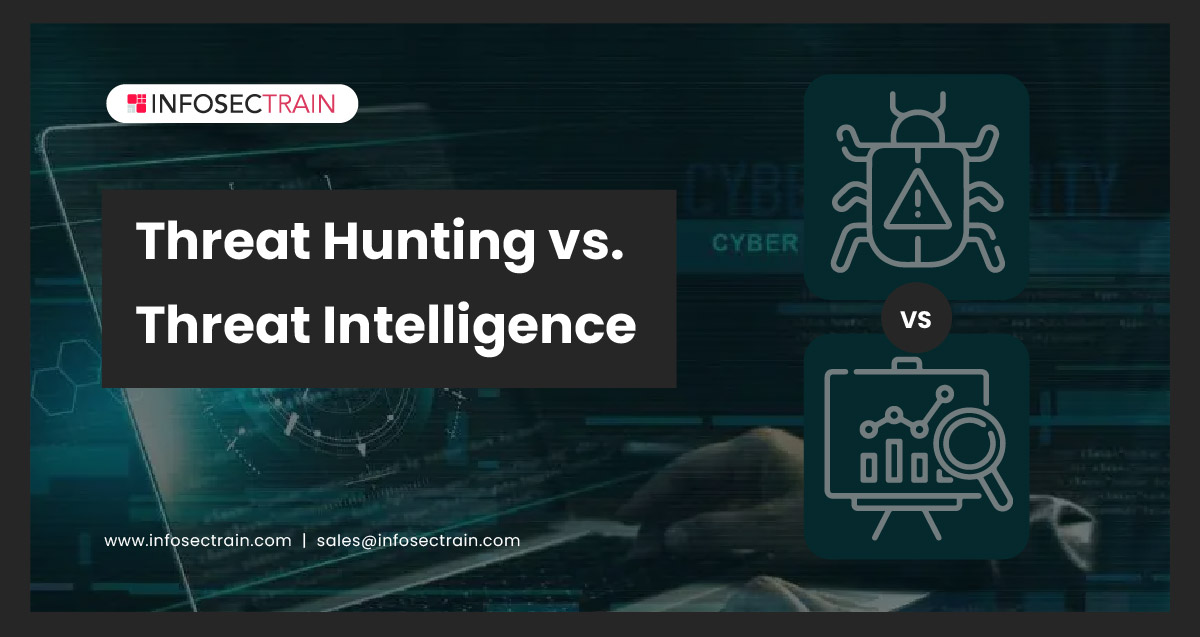Threat Hunting Vs. Threat Intelligence

Table of Contents
Threat hunting: What is It?
The Importance of Threat Hunting
Threat Intelligence:What is It?
The Importance of Threat Intelligence
Threat hunting: What is it?
Threat hunting is the practice of identifying cyber threats that go unnoticed inside a network or data, including endpoints. The procedure entails delving deeply into the environment in order to identify harmful actors.
Threat hunting is crucial for avoiding such attacks. Attackers or hackers may remain undetected within a network for months, secretly collecting data login passwords and eavesdropping on your private information.
The following actions must be taken to conduct an effective threat search:
1. The Trigger: Advanced detection systems might discover unusual behavior indicative of malicious activity, alerting threat hunters to investigate a specific computer or network segment. Often, a thought about an emerging threat can serve as a trigger for proactive hunting. For instance, a security team might investigate potential future threats that exploit current defenses using fileless malware.
2. Investigation: During the investigation phase, the threat hunter makes extensive use of technologies such as EDR (Endpoint Detection and Response) to assess a system’s vulnerability to hostile intrusion. The investigation will go on until it is clear that the activity is not harmful or that all of the information about the bad behavior is known.
3. Resolution: The findings from the investigation phase equip operations and security teams with the information needed to respond to incidents and mitigate risks during the resolution phase. Data from both benign and malicious behavior can be used to improve automation systems, reducing the need for manual intervention.
Cyber threat hunters use this procedure to gather information about attackers’ tactics, and objectives. This knowledge is then used to predict future security improvements and address existing vulnerabilities.
The Importance of Threat Hunting
Investigate security incidents in a proactive manner
In the end, the goal of threat hunting is to identify cybercriminals who have already gained access to the organization’s systems and networks. It may assist in proactively detecting attackers who have already infiltrated the network’s defenses and established a hostile presence. Hunting essentially tracks down active cybercriminals.
Speeds up the investigation
Threat hunting gives a security team more information about an incident, from figuring out how big it is to finding out what caused it and predicting how bad it will be. An active approach, such as analyzing computer network traffic to look for malicious content to investigate possible compromises and improve cyber defenses, can help gather important data that can be used to look into after-the-fact incidents. This translates to faster identification of lessons learned and problem resolution.
Improves the efficiency of a Security Operations Center (SOC)
Threat hunting has the advantage of being human-centered, proactive, iterative, and analytical. The analysts’ resourcefulness and skill to scrutinize and assess data, together with the tools and frequent monitoring, and behavior-pattern searching, results in fewer false positives and wasted time.
Threat Intelligence:What is It?
Threat intelligence, also called cyber threat intelligence, is information an organization uses to understand the risks that have targeted, will target, or are currently attacking them. This data is used to train for, stop, and detect cyberattacks that try to take advantage of valuable resources.
In a world where a certain number of cyber threats might cause a company to collapse, threat intelligence can be used to assist businesses in many ways. It can gather useful information about these threats, establish effective defensive systems, and manage the risks that might harm its operations and reputation. Cyber threat intelligence gives you the power to fight back more quickly against specific threats and attacks.
Threat intelligence is evidence-based information about an actual or developing threat or hazard to assets, including context, processes, indications, consequences, and actionable recommendations. This information may be utilized to judge how the subject should respond to the threat or risk.
The Importance of Threat Intelligence
Reducing data loss: Threat intelligence helps prevent known malicious domains and IP addresses associated with global threat actors from infiltrating your environment. By blocking these known threats, attackers are prevented from using the same malicious avenues to deploy information-stealing malware or ransomware within your network, ultimately enhancing data security.
Keeping up with evolving modes of attack: Threat intelligence also provides information on the most recent attack methods. Phishing emails, for example, are used to launch the majority of cyberattacks these days. This information may be used to prevent intruders from gaining access. In the case of phishing, businesses might set up awareness programs for their employees so that phishing doesn’t lead to a cyber attack.
Why InfosecTrain?
InfosecTrain is a leading security and technology training and consulting organization that specializes in a wide range of IT security and information security services. Customers across the world benefit from InfosecTrain’s comprehensive training and consulting services. InfosecTrain always has the best quality and the best success rate in the market, no matter what kind of service, certification, or training is needed. So if you are interested in learning more about Threat Hunting and Threat Intelligence, do check out InfosecTrain.








 1800-843-7890 (India)
1800-843-7890 (India)